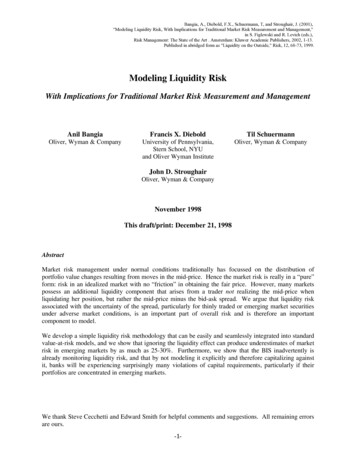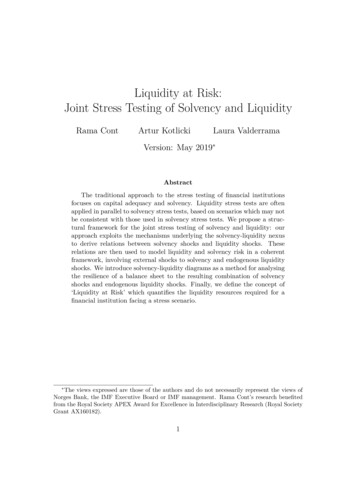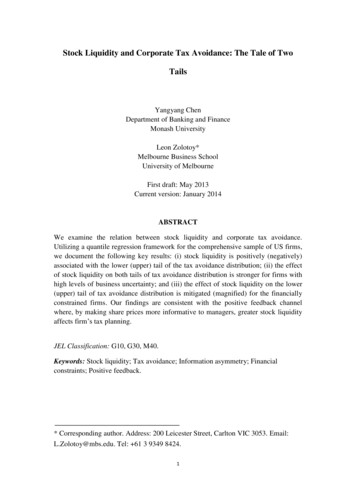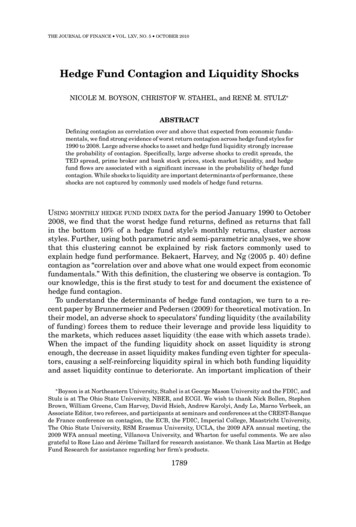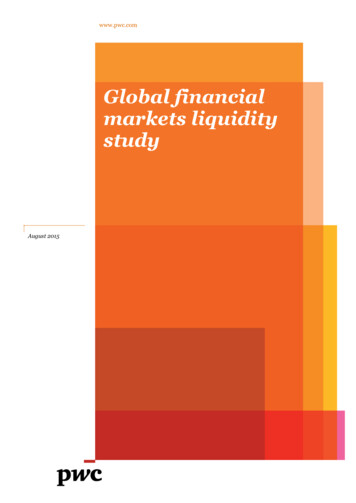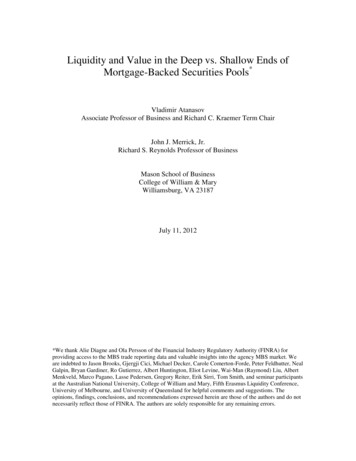
Transcription
Liquidity and Value in the Deep vs. Shallow Ends ofMortgage-Backed Securities Pools*Vladimir AtanasovAssociate Professor of Business and Richard C. Kraemer Term ChairJohn J. Merrick, Jr.Richard S. Reynolds Professor of BusinessMason School of BusinessCollege of William & MaryWilliamsburg, VA 23187July 11, 2012*We thank Alie Diagne and Ola Persson of the Financial Industry Regulatory Authority (FINRA) forproviding access to the MBS trade reporting data and valuable insights into the agency MBS market. Weare indebted to Jason Brooks, Gjergji Cici, Michael Decker, Carole Comerton-Forde, Peter Feldhutter, NealGalpin, Bryan Gardiner, Ro Gutierrez, Albert Huntington, Eliot Levine, Wai-Man (Raymond) Liu, AlbertMenkveld, Marco Pagano, Lasse Pedersen, Gregory Reiter, Erik Sirri, Tom Smith, and seminar participantsat the Australian National University, College of William and Mary, Fifth Erasmus Liquidity Conference,University of Melbourne, and University of Queensland for helpful comments and suggestions. Theopinions, findings, conclusions, and recommendations expressed herein are those of the authors and do notnecessarily reflect those of FINRA. The authors are solely responsible for any remaining errors.
Liquidity and Value in the Deep vs. Shallow Ends of Mortgage-BackedSecurities PoolsAbstractWe use new TRACE data to investigate the liquidity and pricing of agency mortgagebacked pass-through securities. We distinguish between two trading channels -- a To-BeAnnounced (TBA) forward delivery market and a specified-pool market. Institutionalspecified-pool traders in the deep end of the market have easy access to the TBA market,while retail specified-pool traders in the shallow end of the market have virtually noaccess to this market. We first confirm that only large specified-pool transactions showstrong integration with the TBA market in terms of settlement dates and prices. We thenshow that TBA access for traders in the deep end translates into abundant liquidity withbalanced two-way trade flow and realized bid-ask spreads of less than 0.1%. In contrast,retail traders who do not benefit from integration with the TBA market suffer 4-to-1 sell to-buy trade flow imbalance and 0.5% to 1% realized bid-ask spreads. Because trading inthe same security can occur in both the shallow and deep ends of the market, we canestimate the price discounts due to illiquidity by comparing the prices of small and largesized trades. Our empirical tests paint a consistent picture that illiquidity in the shallowend causes 2% to 5% price discounts.
1. IntroductionAgency mortgage-backed securities (MBS) are crucial conduits for housing marketfinance and represent a large share of both total US debt issuance flows and outstanding values.The three sponsoring agencies in the US are the Federal National Mortgage Association(FNMA), commonly known as Fannie Mae; the Federal Home Loan Mortgage Corporation(FHLMC), commonly known as Freddie Mac; and the Government National MortgageAssociation (GNMA), commonly known as Ginnie Mae. Together they issued a total of 1.4trillion in new MBS in 2010. Roughly 5.5 trillion of agency MBS were outstanding as of mid 2011.While the agency guarantee shields investors from default risk, investors remain subjectto substantial cash flow timing risk due to uncertain prepayments tied to loan refinancing. Inaddition, the securities themselves trade in an over-the-counter dealer market. Given theircomplex nature as well as the lack of public trading channels, one might expect the MBS marketto be as fragmented and illiquid as the municipal debt market. Yet, neither complexity norpotential fragmentation has kept the agency MBS from being extremely liquid. The agency MBSmarket has almost 25 times the daily trading volume of the US municipal bond market, and trailsonly Treasuries among all US debt markets.There are two channels for trading agency MBS securities – a specified-pool channel anda “to be announced” (TBA) channel. The majority of trading takes place within the deferreddelivery TBA channel, which has excellent pre-trade transparency via electronic platforms. Incontrast, specified-pool trading has no pre or post-trade transparency. The existing academicliterature for MBS studies TBA contract pricing (Boudoukh et al., 1997; Gabaix, Krishnamurthy,and Vigneron, 2007), but a previous data vacuum has prevented any academic research of1
specified-pool trading. As a result, in stark contrast to the vast body of literature on the pricingand liquidity of equity, government bond, and corporate bond markets, little is known aboutspecified-pool MBS trading and its integration with the TBA market.We present the first comprehensive empirical study of specified-pool trading using newTRACE data collected by the Financial Industry Regulatory Authority (FINRA) from mortgagemarket dealers on all transactions in Fannie Mae mortgage pass-through securities taking placebetween May 16, 2011 and October 31, 2011. These data offer a detailed look into the liquidityand pricing of individual pools and permit estimates of transaction costs using methods appliedby Hong and Warga (2004) and Green, Hollifield, and Schürhoff (2007) to the municipal bondmarket. The data also allow us to analyze the degree of integration between the murky specifiedpool and translucent TBA segments of the MBS market. Finally, we use these new data and aunique research design to quantify the impact of liquidity on security valuation, a key issue inasset pricing research.We find that the pricing process in Fannie Mae specified pools trading performsexceedingly well for transactions of large sizes (the “deep end” of the pool). Indeed, we find nearperfect market integration between the TBA market and the market for those specified pool MBSthat are deliverable on active coupon TBA trades. The majority of large specified-pool tradesoccur on TBA settlement dates and the distribution of prices across the full range of possibledecimal values matches the uniform distribution in the TBA market. The variation in TBApricing also explains between 94% and 97% of the variation in MBS pricing for deep-end tradessized at 25,000 or more in current face value. We next document that institutional investors inthe deep end of the market (who can access both the TBA and specified pool channels) get2
excellent liquidity in specified-pool trading. Trading in the deep end of Fannie MBS occurs atrealized bid-ask spreads of less than 0.1% and we observe customer sell/buy order balance.The features of the TBA market that make it an attractive platform for the large-sizedtrades of institutions also make it costly to access by traders wishing to execute small-sizedtransactions, because of high costs to acquire and bundle small positions in order to comply withTBA delivery guidelines. In marked contrast to our deep-end results, TBA benchmarks explainvery little of the variation in MBS pricing for shallow-end trades. This low level of explainedvariance indicates that there is little price integration of specified pool and TBA markets forsmall-sized trades. Shallow-end trades are five to twenty times more likely to be executed atinteger prices. They also exhibit unbalanced two-way flow, with customer sell volume more thanfour times larger than customer buy volume, and are executed at 0.5% to 1% realized bid-askspreads.After establishing the significant relations between, on one hand, trade size andintegration with the TBA market and, on the other hand, trade size and liquidity, we nextexamine the impact of liquidity on pricing. Amihud, Mendelson, and Pedersen (2005)recommend that test for liquidity effects on asset values involve a comparison of assets withidentical cash flows but differing levels of liquidity. More generally, unbiased estimates of thecausal effect of liquidity on asset values require variation in liquidity that is exogenous to assetprices (e.g. Amihud, Mendelson, and Lauterbach, 1997). Following the recommendation ofAmihud et al (2005), we compare the prices of deep and shallow-end trades in the same specifiedpool within the same day. Based on our previous analysis, deep-end trades in a given security arepriced in a large, liquid market while shallow-end trades in the same exact security are priced ina fragmented, illiquid market. By exploiting this unique opportunity to observe identical streams3
of cash flows that are exposed to different liquidity regimes (i.e., small-sized trades vs. largesized trades in the same security), we do not need to control for other possible confoundingvaluation factors that would be present in the typical cross-sectional or time-series study of theimpacts of liquidity on asset pricing (Amihud and Mendelson, 1991; Kamara, 1994;Krishnamurthy, 2002; Goldreich, Hanke, and Nath, 2005).We find that small-sized specified-pool MBS trades on average price 2% to 5% belowlarge-sized trades in the same specified pool. We interpret these pricing patterns as evidence thatthe lack of liquidity in the shallow-end segment of the specified-pool market causes a significantprice discount to the deep-end segment. More generally, our results show that, in the specifiedpool MBS market, trade size affects fair value in a manner that is over and above the directimpact on effective spreads, documented for municipal bonds by Harris and Piwowar (2006) andGreen, Hollifield, and Schürhoff (2007), and for corporate bonds by Goldstein, Hotchkiss, andSirri (2007) and Feldhütter (2012).The remainder of the paper is structured as follows. Section 2 provides backgroundinformation about MBS trading and institutional characteristics and describes the FINRAcontributed data. Section 3 presents our analyses of the relations between 1) trade size andintegration between the specified-pool and TBA markets and 2) between trade size and liquidity.We perform our empirical tests of the effect of illiquidity on MBS prices in Section 4. Section 5concludes.2. Background and DataA. Trading in Agency MBSA basic type of agency MBS is the pass-through participation certificate that entitles itsowner to a pro-rata share of all principal and interest payments made on a pool of residential4
property loans that conform to underwriting standards set by the sponsoring agency. Vickery andWright (2011) emphasize the liquid over-the-counter dealer market in TBA convention contractsthat call for deferred delivery of “to be announced” pass-through securities as the key to theefficient functioning of the MBS market. The TBA contracts leave the underlying MBS passthrough pool unspecified until the seller chooses the "cheapest to deliver" from a broad set ofeligible pools as the actual delivery process begins. Buyers anticipate this behavior and thereforeprice the contract off of a generic cheapest to deliver pool. The significant level of homogeneityin the agency underwriting and pooling process in combination with rules governing TBAchannel trading generates effective fungibility for a broad class of mortgage-backed securities.The TBA market features characteristics thought to promote liquidity and efficiency:standardized terms and excellent pre-trade transparency. The TBA market’s electronic tradingplatforms display current prices for a range of contracts standardized by an issuer/couponrate/settlement date triplet.1 This market’s price discovery process brings about a balancebetween investor buy and sell orders and allows huge sizes to transact every day. As aconsequence, institutional investors with large scale mortgage product trading needs find TBAcontracting to be a desired liquid channel.2 Furthermore, such TBA trading aggregates pricinginformation about mortgage prepayment risk and other market-wide factors.The fixed-rate agency MBS market naturally partitions along agency issuer and“product” (i.e., the original maturities for the underlying mortgages) dimensions. Trading inTBA contracts for fixed-rate MBS exist for all three issuers (FNMA, FHLMC, and GNMA)1Figure A-1 in the Appendix presents a screen-shot example of Bloomberg Electronic Market for FNMA 30-yearTBA contracts.2 Silber (1981) emphasizes that successful innovation of a futures market to supplement or replace over-the-counterforward markets stems from reducing the cost of contracting. Nothaft, Lekkas, and Wang (1995) suggest that theliquidity of the TBA market doomed the Chicago Board of Trade’s attempt to find market acceptance of its GNMAbased MBS futures contract launched in 1989. Johnston and McConnell (1989) analyze the rise and fall of theChicago Board of Trade’s previous GNMA CDR futures contract that was launched with some success in 1975 buteffectively died out by 1987.5
across four products (30-year; 20-year; 15-year; 10-year). Typically, TBA trading is open forbetween three to six active contract coupon rates and three settlement months. There is onespecific settlement date per product per month. Thus, a TBA contract trade embodies its issuer(e.g., FNMA), product (e.g., 30-yr fixed rate), coupon (e.g., 4%), and settlement date (e.g.,8/11/2011).The limited number of TBA contracts is designed to enhance liquidity and pricediscovery. Other standards such as the Securities Industry and Financial Markets Association(SIFMA) “Good Delivery Guidelines” facilitate trading in large sizes. The SIFMA guidelinesrequire: 1) a 25,000 current face value minimum trade size; 2) all delivered pools should haveoriginal par greater than or equal to 25,000; and 3) limit the number of delivered pools to onefor trades below 500,000 in current face value, two for trades between 500,000 and 1 millionin current face, and three per million for trades above 1 million in current face.3 Theseguidelines make TBA delivery of pools with small current face values inconvenient. For exampleto deliver a pool with current face of 24,000, one would need to bundle this pool with anotherpool with 476,000 current face with the same issuer, product type and coupon.For deep-end investors having large enough MBS holdings to comply with TBA deliveryguidelines, the trading conventions simplify their analytical and risk management challenges.The price of any TBA-eligible specified pool should sell for at least the delivery value of thepool against its respective TBA contract. Thus, deep-end market participants should view theTBA channel as an extremely liquid backstop, which ensures a price floor equal to the currentprice of the corresponding standardized TBA contract. Assuming a “fair” TBA market, deep-endinvestors need only analyze the “pay-up,” the difference between quoted specified-pool and TBA3 Theseguidelines apply to TBA trades with coupons less than 8%, which cover all trades in our sample.6
prices. This pay-up is related to the difference in the prepayment rate of the specified pool versusthat of the generic cheapest-to-deliver pool driving TBA trading.All of the positive pricing and liquidity spillovers of the TBA market to the specifiedpool market do not accrue to shallow-end investors who face high costs of complying with TBAdelivery guidelines. There are mechanisms offered by each of the three GSEs to bundle smallsized pools into a pool of pools that has a single CUSIP and is treated as a single pool for tradingand TBA delivery purposes. Theoretically, this pooling-of-pools process could provide a bridgebetween the shallow and deep ends of the specified-pool market. It is an empirical questionwhether the costs of pooling-of-pools are small enough to enable full integration between theshallow and deep ends of the market.B. DataFINRA extended TRACE reporting requirements to securitized products on May 16,2011. As of that date, FINRA required member firms to report trades executed in asset-backedand mortgage-backed securities.4 These new report requirements encompass all agency MBStrades, both specified-pool and TBA. FINRA provided these transactions data to us for the periodfrom May 16, 2011 and October 31, 2011. During our sample period FINRA collected but didnot yet publicly disseminate the trade-by-trade results.5 FINRA began releasing weeklyaggregated market activity summaries on October 18, 2011. 64See @notice/documents/industry/p121319.pdf.A substantial literature has investigated the impacts of TRACE trade dissemination on trading costs in the UScorporate bond market: Bessembinder, Maxwell, and Venkataraman (2006), Edwards, Harris, and Piwowar (2007),and Goldstein, Hotchkiss, and Sirri (2007). Furthermore, Cici, Gibson, and Merrick (2011) suggest that observeddeclines in the dispersion of month-end valuations placed on identical corporate bonds by different mutual fundsmay be due in part to the rollout of TRACE trade dissemination. Notice that our MBS and TBA TRACE data is notbeing disseminated during our sample period and we are not examining any information effects of specific tradereports on MBS prices.6These end-of-day aggregated market activity summaries are available atwww.finra.org/TRACE/StructuredProductsReports and https://vantage.interactivedata.com/aggregate.57
Each specified-pool trade report includes a security identifier (e.g., CUSIP), transactionsize (measured by convention as the original face value of MBS traded), date and time ofexecution, settlement date, trade price, pool factor (if not the most recently published factor), anda variety of codes defining trade type. The latter include flags for counterparty type (dealer buy,dealer sell, customer buy, customer sell) and dealer capacity (principal or agent). Commissions(if any) must be built into the reported prices.We expunge duplicate trade reports arising from interdealer trades by dropping all“dealer buy” reports. We then remove cancelled trades and keep only the last trade correctionreport in sequences of original trade, and one or more corrections. We check the resultingtransaction data for discernible errors and drop several outliers.7FINRA also provided a securities database encompassing individual MBS terms andselected pool characteristics. The securities database includes characteristics like issuer,collateral type, issue date, original balance, weighted average loan balance, credit score, couponand factor as of month end for May to October. We merge this database with the transactionsdata to link trade prices with underlying pool characteristics.We focus only on pass-through securities issued by Fannie Mae based on conventionalfixed coupon single-family mortgages and the corresponding TBA contracts. There are four maintypes of pools categorized by maximum maturity for a pool’s constituent mortgages: 10-year, 15 year, 20-year, and 30-year.Table 1 presents summary statistics for trading in each of the four product maturitysectors for both TBA contracts and those specified pool MBS that match standard TBA coupons.7Understandably, the rollout of new reporting requirements may cause confusion on the part of some participantsearly in the process. For example, we uncovered and subsequently dropped numerous trade reports from one dealerwho reported trades for sizes equal to entire multi-million dollar MBS pools at identical prices of 100 (even thoughthe matched TBA prices were above 109). These reports most likely represented MBS swap trades between thedealer and issuer FNMA.8
We categorize trades in each product and market by dealer counterparty (i.e., another dealer, acustomer who buys, and a customer who sells). These results clearly show that the TBA marketis the dominant trading channel for MBS. For example, the total volume of interdealer trades inthe TBA market is more than sixty times that of specified-pool trades. Moreover, the implied 20million average size of all interdealer TBA trades is almost seven times as large as the 3 millionaverage interdealer specified-pool trade. Insert Table 1 Furthermore, the TBA market is well balanced in terms of customer order flow in thesense that the volume of customer purchases roughly equals the volume of customer sales.Dealers keep busy servicing this customer flow: the (unduplicated) volume of interdealer tradesis more than double each side of their customer volume. Note that the specified pool market isnot as well balanced. The total volume of customer buy trades is only about 75% of customer selltrade volume. Moreover, the total volume of interdealer trading in specified pools is dramaticallylower than even the customer buy volume.The 30-year and 15-year product segments of the TBA market are by far the most active.The low level of trading volume in the 10-year and 20-year products limits our ability toreference a reliable TBA benchmark price to match any particular corresponding specified pooltrade. Thus, we drop the 10-year and 20-year products from the remainder of our analysis. Notethat this restriction decreases our volume coverage of all customer TBA trades by less than 0.5%.The remaining sample of MBS trades includes securities with coupons ranging from 2.5% to11% for 15-year and from 3% to 16% for 30-year products. Again, we keep only MBS withcoupons that match the actively traded TBA coupons for our sample. These active coupon rates9
range between 3% and 6% for 15-year product and between 3.5% and 6.5% for 30-year product.This restriction reduces the sample by about 5%.The TBA market provides a natural set of price benchmarks for specified-pool tradeswith the same collateral type, coupon, and settlement date. Before proceeding to create theseprice benchmarks, we must recognize that the FINRA database includes four different types ofTBA trades. “Stipulated trades” differ from regular trades by placing restrictions on the poolsthat can be delivered in final settlement.8 The third category of trades is a “dollar roll.” A dollarroll is a linked pair of trades in which, say, a customer agrees to both sell an August settlementcontract and buy a September settlement contract. In this way the customer maintains generalrisk exposure to the mortgage market (via being long the September contract), but has no right toany cash flows between the two settlement dates. The fourth category is for stipulated dollar rolltrades (i.e., dollar roll trades that entail delivery restrictions). Table A-1 in the Appendix reportsstatistics on trading volume and the number of trade by each counterparty type for the fourdifferent types of TBA trades. This activity breakdown reveals regular trades to be largest type oftrade followed by dollar rolls. Both types of stipulated trades are minor components of themarket.We drop all non-regular TBA trades – stipulated, dollar rolls, and stipulated dollar rolltrades from the data and proceed with the construction of TBA price benchmarks for eachspecified-pool trade in our sample. We separate the MBS trades into two categories – 1) tradeswith a settlement date that matches the settlement date of the relevant TBA contract (TBAsettlement date trades); and 2) trades with settlement dates different from the settlement dates ofthe TBA contract (non-TBA settlement date trades). For the TBA settlement date trades, the8Stipulations can be placed on, among other things, year of issuance, weighted average coupon, loan age,geographic concentration, pools per trade, etc.10
TBA price benchmark is just the weighted-average price of TBA trades on the same executiondate for the same collateral type (15 or 30-year), same coupon, and same settlement date. Fornon-TBA settlement date trades, we make a crude adjustment for net financing impact onbenchmark value for each MBS trade by using the “Drop” implied by the difference in the frontmonth and next deferred TBA contract prices.9 Define the TBA “Drop per day” as the differencebetween weighted average daily prices of the front (priceTBA1) and next deferred TBA contractprices (priceTBA2) divided by the number of days between their respective TBA settlementdays:TBA Drop per day (priceTBA1 – priceTBA2)/(Days between TBA Settlements)For non-TBA settlement date trades, we use the number of days between the MBS settlementdate and the front month TBA settlement date (MBS Days between Settlements) to calculate theTBA price benchmark as:TBA price benchmark priceTBA1 (MBS Days between Settlements*TBA Drop per Day)We define the pay-up of each MBS trade in our sample as: 10Pay-up price MBS – TBA price benchmark3. Analysis of Specified-Pool Trades: Integration with the TBA market and LiquidityWe first investigate two dimensions of possible integration between specified-pool tradesin 15-year and 30-year conventional Fannie MBS and the corresponding trading in the TBAmarket. The first dimension is the percentage of trades executed at TBA settlement dates. Thesecond dimension is the mass of the distribution of trade prices clustered at integer values. The9See Chaudhary (2006) for a discussion of the “drop” implicit in the pricing of dollar roll trades.The pay-up concept for specified pool MBS for a standard TBA settlement date is akin to the “net basis” foran individual Treasury security calculated relative to its futures market delivery invoice price. Only thecheapest-to-delivery cash market Treasury issue(s) should be delivered against a Treasury futures contract.Any Treasury issue that is worth more than its Treasury futures delivery invoice price should be sold in thecash market at a positive spread (net basis) to its benchmark delivery value rather than be delivered againstthe futures (see Merrick, Naik, and Yadav, 2005). Likewise, absent market frictions, high-value pools shouldnot be delivered against TBA trades. Such pools should trade only in the specified pool market.1011
TBA market trades in increments of one 64th of a price point and there is no clustering aroundparticular price values, e.g. 0, ¼, ½, or ¾ (see Table A-2 about the percentage of TBA tradeswith integer prices). If specified-pool trades are driven by TBA prices, their pricing will also beuniformly distributed without any clustering at round values. We report the percentage of tradesthat settle on TBA dates and occur at integer prices for different trade-size categories in Table 2.Consistent with differential access to the TBA market, there are monotone relations betweentrade size and both the percentage of trades executed at TBA settlement dates and the percentageof trades executed at integer prices. The differences in both categories observed for large versussmall trade sizes is striking. Compare small trades below 5,000 with large trades above 250,000 in current face. As little as 15% of the small trades settle on TBA dates and as much as42% occur at integer prices. Conversely, 70% of the large trades settle on TBA dates and only2% have integer prices. We interpret these patterns as indirect evidence that specified pool MBSmarket participants prefer to link to the TBA market to discipline negotiations with dealercounterparties, especially for transactions of large size. Insert Table 2 Figure 1 overlays the distribution of various individual specified pool MBS transactionsprices against a daily plot of the price on the 30-year, 5% coupon, August 2011 TBA contract,restricting the sample only to trades with the same settlement date as the August 2011 TBAcontract (August 11, 2011). The MBS trades are categorized as large trades, small buys, andsmall sells. A 25,000 current face value cutoff is used to define large versus small trades.Figure 1 shows that large specified-pool trade prices generally are equal to or greater than theirassociated TBA benchmark prices (i.e., large specified-pool trade prices respect theircorresponding TBA benchmark price floor). In contrast, small specified-pool sell trades occur at12
large discounts to corresponding TBA prices. Many small sells are priced between 3% and 5%through their respective TBA floors (i.e., “cheap”). One small sell takes place at an egregiousdiscount of over 25%. Interestingly, small buys can also occur at prices below the TBAbenchmark. Based on Table 2, most small trades do not have an exact TBA settlement date.Figure A-2 in the Appendix expands the sample to all small trades executed after July 10 withsettlement date on or before the August 2011 TBA settlement date. Compared to Figure 1, theplots include many more small trades, but conclusions about the prices of small trades remain thesame. Insert Figure 1 Table 3 reports results of panel data regressions of specified-pool trade prices on theirmatched TBA benchmark prices for 30-year product. As previously discussed, the TBAbenchmark prices match each MBS trade by product and coupon, and either match settlementdate for TBA settlement date trades or adjust for the dollar roll for non-TBA settlement dates.These regressions aim to offer some basic insights about the degree to which specified-pool tradeprices can be explained by matched TBA benchmark prices. We delve into differences owing totransaction size by running separate regressions for large trades and small trades. Panel Areports results for large trades, again defined as trades sized above 25,000 of current face value.These estimates clearly show the importance of trade size in determining how prices in thespecified pool MBS and TBA markets co-move. The estimated slope coefficients from the largetrade sample are quite close in magnitude to 1.0 regardless of counterparty type. Furthermore,the R-squared statistics range between 0.94 and 0.97, implying almost perfect market integrationeven for non-TBA settlement date trades.13
Panel B reports results for trades sized below 25,000 of current face value. Theestimated slope coefficients from the small trade sample are much lower than one in magnitudefor every counterparty type. Furthermore, the R-squared statistics are shockingly low, rangingbetween 0.03 and 0.41. These results suggest that very little integration exists between specifiedpool small trade pricing and the corresponding TBA benchmarks.
balanced two-way trade flow and realized bid-ask spreads of less than 0.1%. In contrast, retail traders who do not benefit from integration with the TBA market suffer 4-to-1 sell to-buy trade flow imbalance and 0.5% to 1% realized bid-ask spreads. Because trading in the same security can occur in both the shallow and deep ends of the market .



